


![]()
1 & 3 feature his unpublished
The Book of Death series done in 1911
Kay (pronounced "kigh") Nielsen is considered one of a triumvirate of classic "great " illustrators from the golden age of illustration and gift book design during the first quarter of the 20th century. Arthur Rackham and Edmund Dulac were the other stars. (Yes, I know that there were dozens of others plying their trade in the same market, W. Heath Robinson not the least of them.)
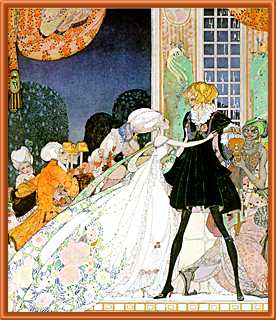 Arthur Rackham (born in
1867) looked to the work of the romantic school of art for inspiration.
So did the early efforts of Dulac
(born 1882). Nielsen (1886-1957) was influenced from the start
by the more "modern" styles of Beardsley, Burne-Jones
and the influx of Japanese art that was spreading to the West
at this time. The books he illustrated were generally distinct
from those of his contemporaries, too. Where Rackham did The
Ingoldsby Legends and Dulac, Tanglewood Tales, both
classics of the 19th Century, Nielsen chose In Powder and Crinoline
(1913). This Arthur Quiller-Couch book is a distinctively 20th
Century book that Nielsen made his own. It was published in America
as Twelve Dancing Princesses. To this day, few artists
have dared to attempt a different version.
Arthur Rackham (born in
1867) looked to the work of the romantic school of art for inspiration.
So did the early efforts of Dulac
(born 1882). Nielsen (1886-1957) was influenced from the start
by the more "modern" styles of Beardsley, Burne-Jones
and the influx of Japanese art that was spreading to the West
at this time. The books he illustrated were generally distinct
from those of his contemporaries, too. Where Rackham did The
Ingoldsby Legends and Dulac, Tanglewood Tales, both
classics of the 19th Century, Nielsen chose In Powder and Crinoline
(1913). This Arthur Quiller-Couch book is a distinctively 20th
Century book that Nielsen made his own. It was published in America
as Twelve Dancing Princesses. To this day, few artists
have dared to attempt a different version.
Nielsen was born in Denmark and studied art in Paris. To his artistic influences must be added John Bauer, the great Swedish fairy tale artist. Echoes of his forests and trees lurk in the backgrounds of many of Nielsen's paintings. Art Nouveau and The Birmingham School, as exemplified by Jessie M. King, were also part of the raw materials he assimilated in search of a style.
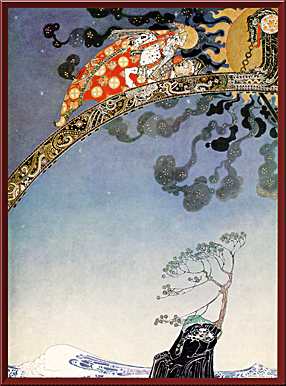 His second
great book, arguably his masterpiece, was East of the Sun and
West of the Moon (1914). The image at right is a wonderful
example of his use of various design elements. Note especially
the Hiroshige wave. The composition is striking, the colors both
subtle and bold, and the design elements demand constant reinspection.
Most of all, the picture is memorable. Once you've seen it, you
can't forget it - or the story it illustrated. The detail below
helps to express the powerful lure and density of Nielsen's vision.
His second
great book, arguably his masterpiece, was East of the Sun and
West of the Moon (1914). The image at right is a wonderful
example of his use of various design elements. Note especially
the Hiroshige wave. The composition is striking, the colors both
subtle and bold, and the design elements demand constant reinspection.
Most of all, the picture is memorable. Once you've seen it, you
can't forget it - or the story it illustrated. The detail below
helps to express the powerful lure and density of Nielsen's vision.
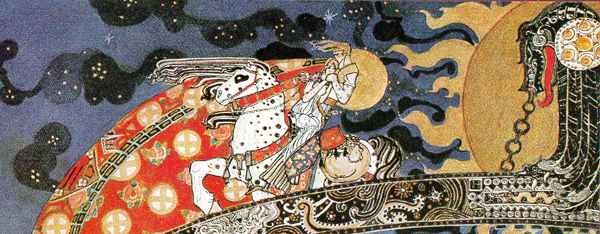
East of the Sun and West of the Moon was another
book that Nielsen appropriated for himself. Written by Gudrun
Thorne-Thomsen, the fifteen Nordic tales were seldom attempted
by another artist. Until the Mercer Mayer edition of 1980 (which
only illustrated the title tale), I can't recall another memorable
version. Nielsen's 25 watercolors so captured the spirit and beauty
of the subject matter that they've served as a visual intimidator
ever since.
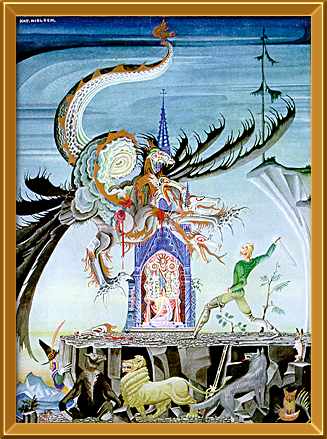 World
War I was a great interrupter in Nielsen's life and career. The
momentum that he had achieved was thwarted and he published nothing
until 1924. The intervening years were spent in Copenhagen where
he was active in theater production. The 1924 book was Hans
Andersen's Fairy Tales, a project begun in 1912 and an obligatory
task for any Danish illustrator. This was followed by Hansel
and Gretel and Other Stories By The Brothers Grimm in 1925
(see image at right). Both were lavish enough, but were inherently
more modest productions with twelve plates each. They seemed to
rejuvenate neither Nielsen's career nor the flagging market for
gift books. Kay returned once more to Copenhagen and the theater.
World
War I was a great interrupter in Nielsen's life and career. The
momentum that he had achieved was thwarted and he published nothing
until 1924. The intervening years were spent in Copenhagen where
he was active in theater production. The 1924 book was Hans
Andersen's Fairy Tales, a project begun in 1912 and an obligatory
task for any Danish illustrator. This was followed by Hansel
and Gretel and Other Stories By The Brothers Grimm in 1925
(see image at right). Both were lavish enough, but were inherently
more modest productions with twelve plates each. They seemed to
rejuvenate neither Nielsen's career nor the flagging market for
gift books. Kay returned once more to Copenhagen and the theater.
He and his collaborator, Johannes Poulsen, staged many fantastic productions including Aladdin, The Tempest and A Midsummer Night's Dream. They were invited to stage Max Reinhardt's Everyman at the Hollywood Bowl in 1936 and Nielsen and his wife, Ulla, came to California. After Poulsen's death, Nielsen chose to remain and try his hand in the animation business. He applied for work at Walt Disney Productions.
According to John Canemaker in his excellent Before the Animation Begins, Nielsen's working pace had always been leisurely, but his vision was so unique that Disney set up an "inspirational assembly line" with Albert Hurter feeding him general ideas. Nielsen would render scenes in pastel in his own style and pass them on to other artists who would supply additional scenes in a similar style or simplified versions for animation guides. Both the style and pace of animation were very foreign to Nielsen. The hard edges and simpler shapes needed for the process were the antithesis of his soft and ornate pastels. The need for speed was a severe problem for a fifty-year-old. The industry was famous for wearing out much younger men and Kay was never fast to begin with. Couple those factors with the intense studio effort to produce Fantasia and Nielsen's career was destined for an early end.
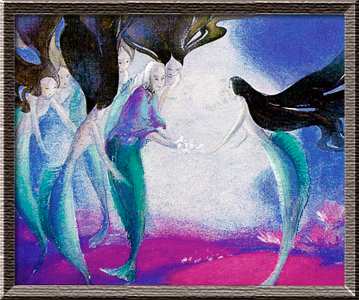 Nielsen's designs
were featured in the "Ave Maria" and "Night
on Bald Mountain" sequences of Fantasia, but in
1940 he was laid off. He was brought back to work on designs for
a Fantasia sequel that was discontinued after the disappointing
showing of the original at the box office. He did some drawings
for a version of The Little Mermaid, a film that had to
wait almost 50 years to be made. Nielsen was given a posthumous
screen credit as one of the designers.
Nielsen's designs
were featured in the "Ave Maria" and "Night
on Bald Mountain" sequences of Fantasia, but in
1940 he was laid off. He was brought back to work on designs for
a Fantasia sequel that was discontinued after the disappointing
showing of the original at the box office. He did some drawings
for a version of The Little Mermaid, a film that had to
wait almost 50 years to be made. Nielsen was given a posthumous
screen credit as one of the designers.
He died in 1957 in poverty. The home he lived in and much of
the necessities of his life for his last decades had been provided
by local friends. His work during those decades was comprised
of four local mural commissions for schools and a church. His
wife, Ulla, died a year later. In 1975, David Larkin published
Kay Nielsen, a collection of his work in his series of
books on illustrators of the golden age. Suddenly his work was
appreciated and loved again. Two years later, two of the Nielsens'
friends came forward with a set of 42 paintings he had done years
before for an unpublished edition of A Thousand and One Nights.
They had carefully held the canvasses in trust after his death,
certain that he would again be acknowledged by the public. The
Unknown Paintings of Kay Nielsen also contains a moving and
loving tribute to Nielsen by Hildegarde Flanner. She was one of
the custodians of the paintings and a neighbor who had supported
and treasured her once-famous friends.
 To learn more about Kay Nielsen, see:
To learn more about Kay Nielsen, see:
| Before the Animation Begins | John Canemaker, 1996 Hyperion |
| The Illustrated Gift Book | Michael Felmingham, 1989 Wildwood House |
| Book Illustrators of the Twentieth Century | Brigid Peppin & Lucy Micklethwait, 1984 Arco |
| A Treasury of the Great Children's Book Illustrators | Susan E. Meyer, 1983 Abradale/Abrams |
| The Dictionary of British Book Illustrators and Caricaturists 1800-1914 | Simon Houfe, 1981 Antique Collectors' Club |
| The Unknown Paintings of Kay Nielsen | David Larkin, 1977 Peacock/Bantam |
| Kay Nielsen, An Appreciation | Welleran Poltarnees, 1976 Green Tiger |
| Kay Nielsen | David Larkin, 1975 Peacock/Bantam |
| The Vadeboncoeur Collection of Knowledge | Jim Vadeboncoeur, Jr. 1998 |
| The Vadeboncoeur Collection of ImageS 5, 11, B&W ImageS 1, 3 | Jim Vadeboncoeur, Jr. 2002, 2003, 2006, 2009 JVJ Publishing |
| Some illustrations copyright by Walt Disney Productions, et al. This page written, designed & © 1998 by Jim Vadeboncoeur, Jr. Updated 2011. |

